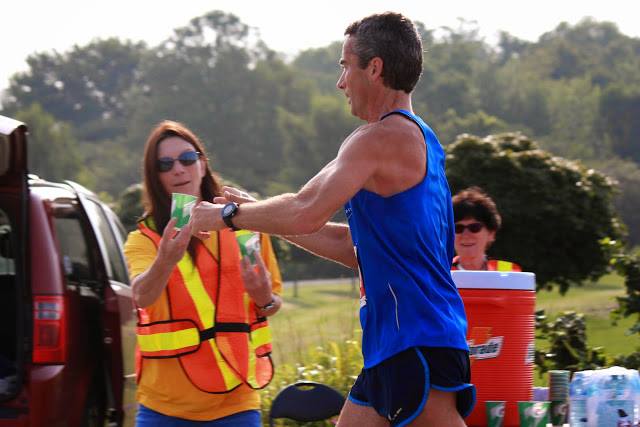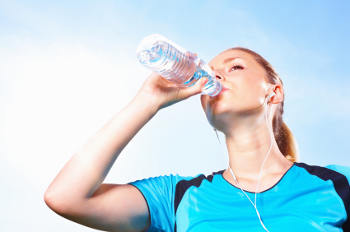 The fall marathon season is finally upon us! With a massive summer of training in the books, it would be a shame to put that hard work to waste with improper nutrition on race day. One very important component of this, without a doubt, is fluid intake. But just how much should you you consume?
The fall marathon season is finally upon us! With a massive summer of training in the books, it would be a shame to put that hard work to waste with improper nutrition on race day. One very important component of this, without a doubt, is fluid intake. But just how much should you you consume?
General guidelines
The American College of Sports Medicine makes the following recommendation: 5-8 ounces of fluid every 15 minute for events lasting over 40 minutes. This is a good, general, safe guideline (I guess). If you don’t want to give your fluid intake any thought, this is a reasonable plan to follow, but I personally don’t like it.
Sweating and performance
 The reason I don’t like it is fluid intake needs are extremely variable depending on a number of factors, most importantly, your personal sweat rate. The average person will sweat anywhere from 1-2L/hour (which is a massive range). It is well documented that there are outliers to this range too. For instance, one of the best marathoners of all time, Alberto Salazar, has been noted to lose upward of 4L/hour!
The reason I don’t like it is fluid intake needs are extremely variable depending on a number of factors, most importantly, your personal sweat rate. The average person will sweat anywhere from 1-2L/hour (which is a massive range). It is well documented that there are outliers to this range too. For instance, one of the best marathoners of all time, Alberto Salazar, has been noted to lose upward of 4L/hour!
So how do you decide how much fluid you need to take in to maintain performance? Here’s a simple rule: try to lose 4% of your body weight or less. Studies, like this one, have shown that a 4% loss of your body weight will not impair your performance. There are others that show more than a 2% loss in body weight will result in a drop in performance (but this is not as common of a finding).
How to gauge intake
It’s just that easy- don’t lose 4% of your body weight (sarcasm). Obviously this isn’t a good guideline unless you have had the chance to do a number of test runs weighing yourself before and after. A better answer comes from this 2014 study published in European Journal of Applied Physiology.
In the study, athletes ran a half marathon along with two fluid consumption protocols. They either (a) drank according to a pre-designed drinking protocol or (b) drank when they felt thirsty. When the athletes drank according to thirst, this is what happened: they lost more weight, their body temperatures went up, and their heart rates were elevated.
How did this impact performance though? It didn’t. The half marathon times were the same despite the physiological differences seen in response to drinking according to thirst.
This comes back to something I think we often forget about: the functional adaptability that our bodies possess. Perfect conditions are not ALWAYS needed to produce perfect results. If you lose some blood volume because of sweating, well we can adapt via increasing HR. There clearly is a breaking point with excess fluid loss, but don’t be afraid or discouraged if you miss an aid station- our bodies are resilient, and have an amazing ability to produce similar results under a wide range of conditions. However, if you skip an aid station and believe you will slow down as a result, I guarantee you actually will slow down independently of your hydration status.
Practical application
 Basically I just went through a fancy way of saying, “drink when you are thirsty.” I think letting thirst be you guide is a solid approach just as long as you are actually conscious enough to listen to that thirst.
Basically I just went through a fancy way of saying, “drink when you are thirsty.” I think letting thirst be you guide is a solid approach just as long as you are actually conscious enough to listen to that thirst.
One situation where this method could become problematic is if you are the type of athlete to get into the zone and tune out all discomfort, including thirst. If this is you, then having a methodical plan based on your personal sweat rate and race day conditions to make sure you do not lose more than 4% of your body weight should be implemented.
Another problem I see with this thirst-driven program is the availability of fluids on race day. If you race with a fuel belt, then you are good to go. I, on the other hand, am at the mercy aid station distribution. So if I hit the first aid station, but I don’t feel thirsty, is it reasonable to still drink something? I think so.
So my advice is to use thirst as a general guideline of when to drink. If you are thirsty, listen to that urge, and take on fluids asap before you start to slow down. However, don’t ignore what has worked for you in the past. It’s always a smart choice to take on some fluid when it’s convenient (even when you’re not thirsty) to emulate what has worked in training.
Dr. Sean Delanghe, BSc. (Hons), DC is a chiropractor, coach, and a regular contributor to the RunWaterloo blog.

